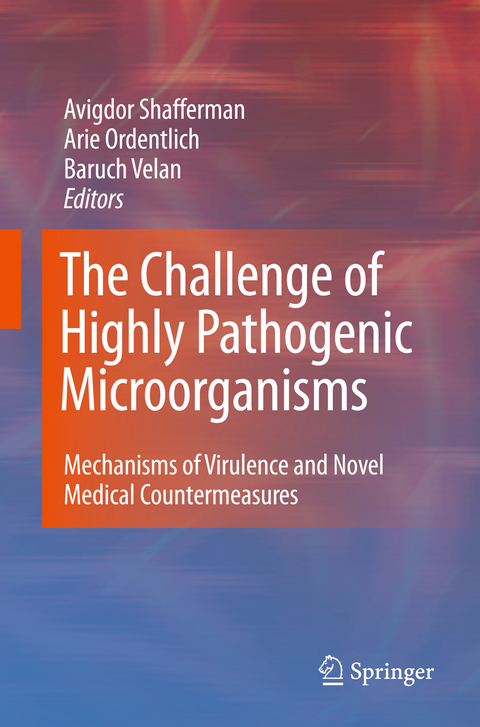The Challenge of Highly Pathogenic Microorganisms
The OHOLO conferences are sponsored by the Israel Institute for Biological Research and take their name from the site of the ?rst meeting on the shores of Lake Kinnereth. The purpose of these meetings is, as it was at their inception over 50 years ago, “to foster interdisciplinary communication between scientists in Israel, and to provide added stimulus by the participation of invited scientists from abroad”. The core of the organizers of the OHOLO conferences are scientists from the Israel Institute for Biological Research. From time to time a particular OHOLO conference cooperates with an international scienti?c organization. The present 46th OHOLO Conference marks the resumption of the OHOLO tradition after 8 years of interruption caused by events beyond our control. It is my belief that our uncomp- mising commitment to excellence in research and development in the various areas of science in Israel is essential to our survival in this troubled region. The OHOLO conference tradition is a re?ection of this conviction. The present 46th OHOLO Conference entitled: The Challenge of Highly Pathogenic Microorganisms – Mechanisms of Virulence and Novel Medical Countermeasures intends to address the unique virulence features and ho- pathogen interactions of microorganisms constituting emerging biothreat with emphasis on Y. pestis, B. anthracis, F. tularensis and Orthopox viruses. Accordingly we selected classical microbiological as well as genomic, proteomic & transcr- tomic approaches towards developments of novel prophylactic and post-exposure treatment, as well as updated strategies of diagnostics and bioforensics.
The Anthrax Capsule: Role in Pathogenesis and Target for Vaccines and Therapeutics.- Proteomic Studies of Bacillus anthracis Reveal In Vitro CO2-Modulation and Expression During Infection of Extracellular Proteases.- Dynamics of Bacillus anthracis Infection and Control Mechanisms.- Survival and Trafficking of Yersinia pestis in Non-acidified Phagosomes in Murine Macrophages.- The Inverse Relationship Between Cytotoxicity of Y. pestis and Its Virulence.- The NlpD Lipoprotein of Yersinia pestis is Essential for Cell Separation and Virulence.- Dissection of the Functions of the IglC Protein of Francisella tularensis.- Yersinia pestis Lipopolysaccharide in Host-Pathogen Interactions.- The Interactions Between Pathogens and Dendritic Cells: From Paralysis of Cells to Their Recruitment for Bacterial Colonization.- Comparative Approaches to Identify Host Factors Specifically Targeted by Yersinia pestis During the Infectious Process.- Poxvirus Entry into Host Cells.- Role of A33R Amino-Acid 118L in the Interactions of Vaccinia Virus with the Host.- Inhibitors of Innate Immunity from Vaccinia Virus.- Brucella Species Synchronize Their Life Cycle to the Gestation Cycle of Their Ruminant Hosts.- MMP-9 as a Marker for Vaccinia Virus Related Encephalitis.- Epidemic Cowpox Virus Infections in Germany.- The Two Partner SecretionTwo Partner Secretion Transporters of Yersinia pestis: Cloning, Immunogenicity and In Vivo Expression Following Airway Infection.- Genetic Detection of Vesicle Forming Pathogens by Arrayed Primer Extension (APEX).- Subtyping Biothreat Bacterial Pathogens.- A Rapid Method for Bacillus anthracis Genotyping.- Tularemia – A Disease with an Uncertain Impact on Public Health.- Consequences of Antibiotic Treatment of Francisella tularensis Airways Infections.-Novel Live Vaccine Candidates Against Airborne Francisella tularensis.- Effect of Disruption of mglA on the Virulence and Immunogenicity of the Francisella tularensis Live Vaccine Strain (LVS).- Data Mining, Bioinformatic and Immunoinformatic Analyses of Francisella tularensis Schu S4 Genome in Search for Novel Vaccine Candidates.- Modified Vaccinia Virus Ankara (MVA) based Vaccines – Immunostimulatory and Protective Capacity.- Therapeutic Potential of Vaccinia Hyper Immune Sera in Mouse Models of Lethal Orthopoxviruses Infection.- A Live Plaque Vaccine Candidate with Improved Safety and Immunogenecity.- Protection Against Plague Afforded by Treatment with Polyclonal ?LcrV and ?F1 Antibodies.- Combination of Anthrax-Toxin Neutralizing Antibodies: Analysis of Synergism/Antagonism Effect.- The Efficacy of Antibiotic Treatment to Cure Guinea Pigs Intranasally Infected with Bacillus anthracis Spores.- Reverse Vaccinology in Bacillus anthracis Bacillus anthracis .
| Erscheint lt. Verlag | 17.6.2010 |
|---|---|
| Zusatzinfo | XVIII, 314 p. |
| Verlagsort | Dordrecht |
| Sprache | englisch |
| Maße | 155 x 235 mm |
| Themenwelt | Medizin / Pharmazie ► Medizinische Fachgebiete ► Mikrobiologie / Infektologie / Reisemedizin |
| Medizin / Pharmazie ► Medizinische Fachgebiete ► Pharmakologie / Pharmakotherapie | |
| Studium ► Querschnittsbereiche ► Infektiologie / Immunologie | |
| Naturwissenschaften ► Biologie ► Mikrobiologie / Immunologie | |
| ISBN-10 | 90-481-9053-3 / 9048190533 |
| ISBN-13 | 978-90-481-9053-9 / 9789048190539 |
| Zustand | Neuware |
| Haben Sie eine Frage zum Produkt? |
aus dem Bereich




